A folded piece of watercolor paper peeks out of MP Landis’s jeans pocket. The artist stands in front of his work — two abstract oil paintings and 10 pieces from a series called “Warehouse Drawings” hang on the wall. Underneath are 15 more unframed Warehouse Drawings. “Every day, that series starts in my pocket — with notes,” Landis says.
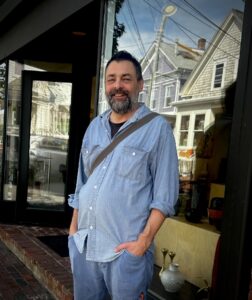
The WD series is all mixed media on thick watercolor paper, roughly 10 x 8.5 inches. Landis doesn’t finish one every day, but he starts a new one and collects them in his studio, where he might be working on 25 at a time. He jots notes on the paper while he works on it — numbers he needs to call, addresses, shopping lists, directions, ideas for later, a list of artworks to pick up from storage — you name it. In his studio, some of the notes get painted over.
In wd2788 (Monk), Landis has applied thinned-down grass-green oil paint over his notes, which are written in graphite. The notes are upside down, some clearer than others — it depends on the thickness of the paint, which is not uniform. Splotches of seafoam green are circled with blue and red china markers, all inside a red wheel.
Landis started the WD series in 1996 in an abandoned warehouse in New Jersey — a friend of his had handed him the keys. The warehouse had no electricity. It was covered in broken glass and occupied by birds. Landis carved out a space to work and drove his van there daily from his home in Park Slope, Brooklyn.
At the time, Landis was feeling trapped by the figurative work he was making. “The Warehouse Drawings were a way out,” he says. “I had no idea I’d be doing this 30 years later.” His mission is to translate the overstimulation of modern urban life into something simpler, more direct, and emotional while showing the layers of his process.
At Bad Habit, Eric Portnoy’s Provincetown art gallery, Landis talks to a curious passerby. She tells him she’s recently stopped painting. “But I’m excited to see your work,” she says. “It’s energy-giving.” And it is: in his work, no color, line, or material is in isolation; everything exists in harmony. Landis’s use of materials — wax, oil, or graphite — is unimpeded by formal adherence to accuracy.
In 2005, the year he turned 40, Landis was listening to Thelonious Monk while making Warehouse Drawings. It affected his art, he says; he attempted to create jazz through a visual language. Those drawings are labeled “Monk.”
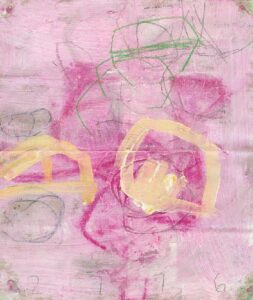
Landis works intuitively. He points to wd2750 (Monk). “It looks like I was figuring out what kind of box I wanted to store things in,” he says of a few penciled notes visible underneath the oil paint. The name of a glaze he needs to pick up, circled in red and crossed out, emerges from behind a swath of sand-colored paint. Over everything, he’s painted a black grid-like figure.
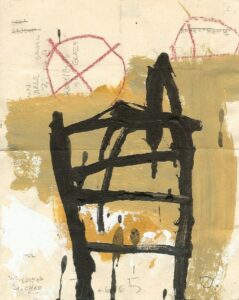
Landis was born in the Mennonite community in Lancaster, Pa. in 1965. His father was a minister. The family was involved in mission work, which allowed him to observe the outside world. Landis worked restaurant jobs growing up in Lancaster and was in the Barons’ Blues Band with “some older fellas,” he says. “I played the harp mostly, some percussion, and I sang a few songs.”
Landis is a self-taught artist. He went to Millersville University in Pennsylvania for two years before dropping out in 1985. “I couldn’t imagine needing a degree for what I wanted to do,” he says. He hadn’t studied art at Millersville — he always knew that he wanted to do it his own way, he says. He and his two friends opened a store, Alexia Books, in Lancaster. The name is a play on words, so to speak. “Alexia,” he says, “is the inability to read words.”
Eventually, Landis felt pulled in too many directions and decided to focus on painting. A friend told him that people came to Provincetown to work in the summer and paint in the winter.
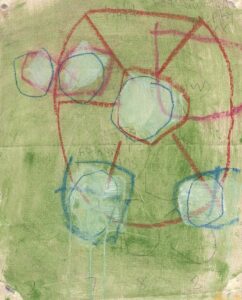
In June 1989, he hitched a ride to Provincetown and stayed for eight years. He quickly met a lot of artists. He worked at Marine Specialties in the summers, poured wine at the Provincetown Group Gallery, waited tables at Blondie’s (now the Grotta Bar), and worked breakfast at Gallerani’s Café (the place that began as Cookie’s Tap and is now Joon Bar). His studio moved around through the years, but he eventually settled into a space at 288B Commercial St., where the old bowling alley used to be, he says. There, Landis worked in the basement. The studio had no sink — he washed his brushes in the public bathroom by the bus station. “I knew all the attendants,” Landis says. He would hustle over before the bathrooms closed at midnight.
Landis worked out of his studio for six years. He hosted radio shows on WOMR: Bird Calls, Jazz Concentrate, and Around Midnight. For a while, he was the jazz director of the station but was never quite sure what that meant, he says. He sometimes painted live on stage at WOMR with a jazz quartet playing behind him.
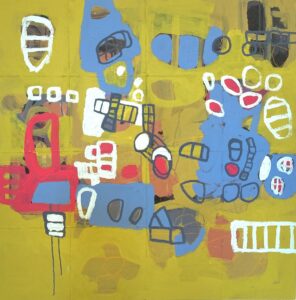
Landis had a show at the Provincetown Art Association and Museum in 1995. “I was a big fish in a small pond,” he says. He now has 11 works from the ’80s and ’90s — mixed media, monoprints, watercolors, silkscreens, and oils — in the PAAM permanent collection.
He felt at home in Provincetown, but in 1996 he needed a change: “I wanted to be anonymous and not know everyone I ran into on the street,” he says, “and I was tired of running out of money in the winter.” He was also getting more involved in the avant garde jazz scene in New York, having discovered a community of musicians and listeners there who were also visual artists and writers. Landis got a place in the Candy Factory, a studio space in Brooklyn.
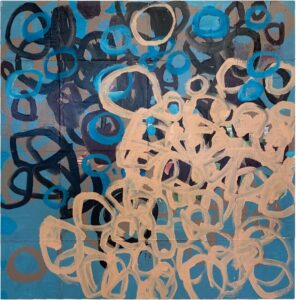
In 2016, he and his wife, Sarah English, moved with their two children to Portland, Maine. He has a garage studio and shows at the Cynthia Winings Gallery in Blue Hill. But he has stayed connected to the Outer Cape — he’s been showing at Farm Projects in Wellfleet for the last 14 years.
His show at Bad Habit, which is up through Oct. 31, includes two recent abstract paintings from 2021 and a fleet of mounted Warehouse Drawings on archival board. “I didn’t want them behind glass,” he says of the drawings. Some are framed by adhering the drawing to the board using heat. “You can really catch the texture, since there’s no glass on it,” says Landis. Some of the drawings remain unframed. Landis is always playing around with how he presents his work.
Landis says he’s going to stop working on the series when he reaches 10,000 drawings. Or maybe sooner: that number might be too big, he says. Maybe he’ll stop at 9,999. Either way, the end is near: he’s at 9,834.
“I probably have four more months to go,” he says.
Habitual
The event: MP Landis’s Warehouse Drawings on exhibit
The time: Through Oct. 31
The place: Bad Habit, 377 Commercial St., Provincetown
The cost: Free



